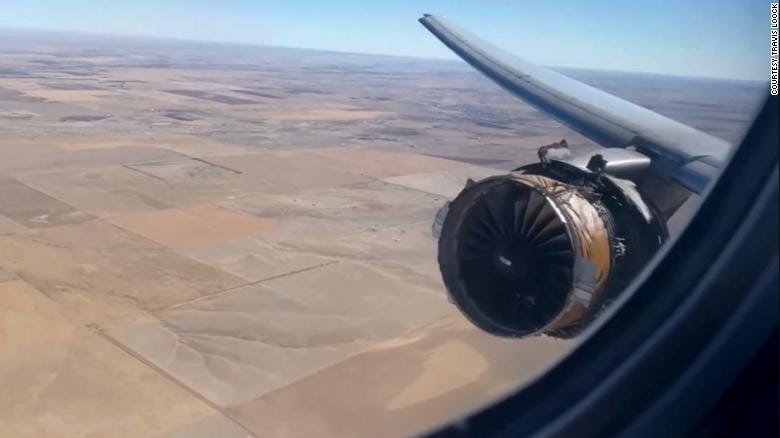Engine failed on United Airlines flight after pilots increased power, NTSB report says
CNN)The right engine of United Airlines Flight 328 failed with a fiery bang minutes after takeoff last month when the aircraft’s pilots throttled up the engines to minimize expected turbulence, National Transportation Safety Board investigators said in an update Friday.
The NTSB update also said a fan blade that failed in the Boeing 777’s engine had most recently received a close inspection for wear and tear in 2016 and was less than halfway to the point of requiring another inspection.The NTSB investigation typically takes a year or more to complete. The seven-page report released Friday did not make any conclusions about the cause of the incident nor did it prescribe further steps for the Federal Aviation Administration, aircraft operators, or the engine manufacturer to make.
According to the update, the flight crew was increasing power “to minimize time in expected turbulence” as the aircraft was climbing to its assigned altitude. The airspace around the Denver airport is known for turbulence, according to CNN affiliate KMGH.
“Immediately after the throttles were advanced a loud bang was recorded” on the cockpit voice recorder, the report said.Travis Loock, a passenger on Flight 328, said it was about 20 minutes after takeoff that he heard a boom.
“There was a big boom and the kind of sound you don’t want to hear when you’re on the airplane,” Loock, who was flying with his wife, told CNN in a phone call after the incident. “And I instantly put my shade up, and I was pretty frightened to see that the, the engine on my side was missing.”
The flight data recorder indicated “the engine made an uncommanded shutdown and the engine fire warning light activated shortly after,” the report said.
The pilots followed procedure to fight the fire, and determined they would not dump fuel to make the aircraft lighter before landing, the report said. They concluded that “the magnitude of the overweight landing was not significant enough to outweigh other considerations.”
Part that failed last inspected in 2016
Investigators said in the days after the incident that preliminary investigation indicated metal fatigue of one blade in the plane’s right engine, and that the blade broke free at the hub, likely hitting another that was broken mid-span.
The NTSB report on Friday said the fan blade that failed was inspected using specialized thermal acoustic imaging technology in both 2014 and 2016. The inspection looks for tiny cracks or signs of metal fatigue which may not be visible to the naked eye.
After a 2018 engine incident on a different plane, the 2016 data was analyzed again, the NTSB said.
The report noted that when the fan blade failed last month, it was less than halfway to the point of requiring another inspection — a detail CNN has previously reported. It had been operated 2,979 cycles, an approximate measure of how many times the engine has been turned on and off. Inspection was required after 6,500 cycles.
Fan blades in the Boeing 777-200's right engine were damaged in the incident on February 20.Fan blades in the Boeing 777-200’s right engine were damaged in the incident on February 20.
Days after the February incident, engine manufacturer Pratt & Whitney recommended dramatically shrinking the interval for the inspection to just 1,000 cycles, according to a service bulletin obtained by CNN. The FAA issued an emergency directive requiring the fan blades on the engines to be inspected before flying again.
The inspection interval for this engine series has been a concern for federal regulators. CNN previously reported a FAA review board met just days before the February engine failure to consider requiring more regular inspections.
In the wake of the engine failure, Boeing has recommended suspending the use of 777s that have the Pratt & Whitney 4000 engine, and United Airlines has already pulled its 777s following the incident. Both the FAA and the NTSB are investigating.
CNN aviation analysts said at the time that such an engine failure was more likely to occur at takeoff, when the aircraft needs more power from the engines.
“If there’s a flaw hidden inside — between all those fans and turbines that are spinning around with such tremendous force and under such tremendous pressure and heat differentials — if there’s a flaw inside there, that’s when you’re going to find out about it,” CNN aviation analyst Miles O’Brien said.
‘Let’s just pray’
The flight was bound for Honolulu when passengers reported hearing a loud boom. Approximately 240 people were on board, and some looked out their windows to see an exposed engine spewing flames as pieces of the plane fell away
CNN)The right engine of United Airlines Flight 328 failed with a fiery bang minutes after takeoff last month when the aircraft’s pilots throttled up the engines to minimize expected turbulence, National Transportation Safety Board investigators said in an update Friday.
The NTSB update also said a fan blade that failed in the Boeing 777’s engine had most recently received a close inspection for wear and tear in 2016 and was less than halfway to the point of requiring another inspection.The NTSB investigation typically takes a year or more to complete. The seven-page report released Friday did not make any conclusions about the cause of the incident nor did it prescribe further steps for the Federal Aviation Administration, aircraft operators, or the engine manufacturer to make.
According to the update, the flight crew was increasing power “to minimize time in expected turbulence” as the aircraft was climbing to its assigned altitude. The airspace around the Denver airport is known for turbulence, according to CNN affiliate KMGH.
“Immediately after the throttles were advanced a loud bang was recorded” on the cockpit voice recorder, the report said.Travis Loock, a passenger on Flight 328, said it was about 20 minutes after takeoff that he heard a boom.
“There was a big boom and the kind of sound you don’t want to hear when you’re on the airplane,” Loock, who was flying with his wife, told CNN in a phone call after the incident. “And I instantly put my shade up, and I was pretty frightened to see that the, the engine on my side was missing.”
The flight data recorder indicated “the engine made an uncommanded shutdown and the engine fire warning light activated shortly after,” the report said.
The pilots followed procedure to fight the fire, and determined they would not dump fuel to make the aircraft lighter before landing, the report said. They concluded that “the magnitude of the overweight landing was not significant enough to outweigh other considerations.”
Part that failed last inspected in 2016
Investigators said in the days after the incident that preliminary investigation indicated metal fatigue of one blade in the plane’s right engine, and that the blade broke free at the hub, likely hitting another that was broken mid-span.
The NTSB report on Friday said the fan blade that failed was inspected using specialized thermal acoustic imaging technology in both 2014 and 2016. The inspection looks for tiny cracks or signs of metal fatigue which may not be visible to the naked eye.
After a 2018 engine incident on a different plane, the 2016 data was analyzed again, the NTSB said.
The report noted that when the fan blade failed last month, it was less than halfway to the point of requiring another inspection — a detail CNN has previously reported. It had been operated 2,979 cycles, an approximate measure of how many times the engine has been turned on and off. Inspection was required after 6,500 cycles.
Fan blades in the Boeing 777-200's right engine were damaged in the incident on February 20.Fan blades in the Boeing 777-200’s right engine were damaged in the incident on February 20.
Days after the February incident, engine manufacturer Pratt & Whitney recommended dramatically shrinking the interval for the inspection to just 1,000 cycles, according to a service bulletin obtained by CNN. The FAA issued an emergency directive requiring the fan blades on the engines to be inspected before flying again.
The inspection interval for this engine series has been a concern for federal regulators. CNN previously reported a FAA review board met just days before the February engine failure to consider requiring more regular inspections.
In the wake of the engine failure, Boeing has recommended suspending the use of 777s that have the Pratt & Whitney 4000 engine, and United Airlines has already pulled its 777s following the incident. Both the FAA and the NTSB are investigating.
CNN aviation analysts said at the time that such an engine failure was more likely to occur at takeoff, when the aircraft needs more power from the engines.
“If there’s a flaw hidden inside — between all those fans and turbines that are spinning around with such tremendous force and under such tremendous pressure and heat differentials — if there’s a flaw inside there, that’s when you’re going to find out about it,” CNN aviation analyst Miles O’Brien said.
‘Let’s just pray’
The flight was bound for Honolulu when passengers reported hearing a loud boom. Approximately 240 people were on board, and some looked out their windows to see an exposed engine spewing flames as pieces of the plane fell away






